Tractor cab filters: are you protected?
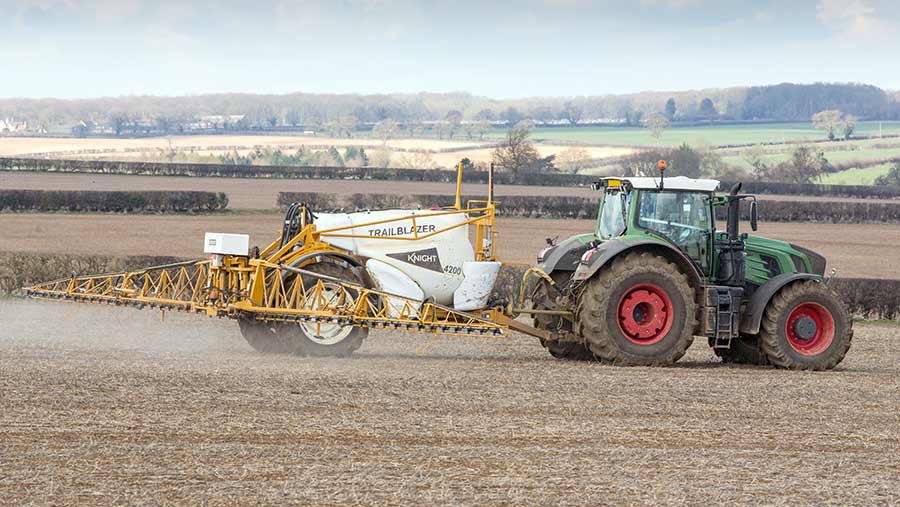 © Tim Scrivener
© Tim Scrivener Most operators and farmers will be well aware of the potential risks that working with agricultural chemicals brings, but with the right precautions, users will be kept free from any worrying issues once the diluted liquid is applied.
If you’ve got a super-expensive self-propelled then you’d expect it to have all the right filters to keep the operator safe, but with the rise in popularity of trailed machines, do tractors offer the same air-tight cabins?
Tractor cabs on the market nowadays have come a long way from the days of spraying with the side window cracked open to keep the air flowing through the cab – climate control and air conditioning are standard fodder on new machines.
See also: 5 ways new tech can improve pesticide applications
However, peel back the comfy seat and leather-clad armrest and most cabs have all kinds of holes for wiring looms and external fittings, meaning they struggle to hold a positive pressure to keep out airborne pollutants without some serious modifications.
EU regulation
The EU regulation on this topic was last revised in January 2018 and enhanced all previous versions stating it was mandatory for any machine applying plant protection products to have Category 4 filtration (see “Categories of filtration”).
Categories of filtration
- Cat 1 – no defined level of protection against hazardous substances
- Cat 2 – protection against dust
- Cat 3 – protection against dust and aerosols
- Cat 4 – protection against dust, aerosols and vapour
- Fitting the system
An EU regulation is legal requirement, binding in its entirety to all members.
This regulation stipulates that dusts, aerosols and gaseous contaminants that arise during the use of toxic substances and liquid fertilisers are not permitted to enter the vehicle cabins.
Other industries are, unsurprisingly, way ahead of agriculture.
Composting loaders are fitted with Cat 4 filtration systems to protect against bioaerosols, while in construction, excavators can be fitted with specialist systems designed to keep the operator safe from hazards such as mercury contamination.
Current cabs
We asked manufacturers what category they currently build to and for comment on the laws and future plans to build tighter cabs.
This is by no means an exhaustive list of makers but represents a large proportion of the machinery sector.
John Deere’s cabs, including on its self-propelled sprayers, leave the factory to Cat 1 standard, although the sprayer does have carbon filters fitted. The one exception is the 5G series speciality cabs, used on orchard tractors.
John Deere does not currently claim to provide protection from hazardous substances under this regulation, although the company would always plan to introduce cabs offering higher certification levels where either legislation demands it, or it believes customers would benefit.
Cabs with cat 4 certification are costlier for the owner to buy and maintain, and John Deere would not wish to force customers to buy such systems if they are not legally required or provide no additional benefit for the specific user.
Claas highlighted that all its cabs leave the factory at Cat 2 level and all tractors have the option of a Cat 3 upgrade. Its Vista II or X10 cab, used by the likes of Agrifac on its self-propelled, can and have been upgraded to Cat 4.
Claas says that upgrades to Cat 3 are available at factory or retrofit, so the option is there for the user to protect themselves if they wish.
All Case-IH tractors leave the factory with Cat 2 filtration and only the Quantum orchard range can be upgraded to Cat 4.
Fendt’s Rogator self-propelled sprayer has standard Cat 4 filtration, while its tractors leave the factory at Cat 2 but have the option to upgrade to active carbon filters. On Profi and ProfiPlus there is the option to overpressure the cab to keep dust out, which is needed for Cat 3 and four. Fendt is working on further protection methods for the future.
Massey Ferguson builds all tractors to Cat 3 standards and said there isn’t an option to upgrade to Cat 4.
The company says they don’t get much demand for upgrades from standard protection and, when asked by customers, it advises that PPE should be worn when its tractors are used for spraying.
McCormick/Landini models come with standard air filters from the factory but have the option to upgrade to carbon filters at a cost of £105 each for a X6 tractor and £75 each for the larger X7 range.
Landini’s Rex 4 orchard tractors has just been launched with a Cat 4 cab option that has regular and carbon filters fitted and the operator flicks a switch when they need the extra protection, improving the life of the expensive filters.
Horsch’s self-propelled PT280 is sold as standard with a Krone cab that has carbon filters to Cat 3 filtration and say the laws are open to different interpretation. However, there are plans to offer Cat 4 cabs as an option on its forthcoming machines, but this won’t be until 2020.
Bateman provides Cat 4 filtration on all of its sprayers.
Sands’ range of Horizon sprayers have featured a Cat 4 filtered cab since 2014.
Chafer offers a Cat 4 cab on its Interceptor.
Househam has Cat 4 on its Predator and Harrier models but not on the Spirit and Air Ride.
Cat 4 cabs must be equipped with an aerosol filter with a separation efficiency of 99.95%. An additional charcoal filter to separate hazardous components of the sprayed pesticide is also required and is the difference between Cat 3 and 4 filtrations.
The law
We consulted the AEA (Agricultural Engineers Association) for the current EU regulation.
It was called EN 15695-1/2 from 2009 and set out the standards for cabs on agricultural and forestry equipment to protect the operator from hazardous substances when applying plant protection products and liquid fertilisers.
Since then there have been revisions to this, most recently when it was republished on 31 January 2018, which only enhanced the original document.
Below is a further regulation (No 167/203) and delegated regulation (No 1322/2014), which is a specific requirement for EU tractors and sprayer applications.
Commission Delegated Regulation (EU) No 1322/2014
Requirements for the cabin
Vehicles of categories T (wheeled tractors) and C (tracked tractors) providing protection against hazardous substances shall be fitted with a cab of level 2, 3 or 4 according to the definition and complying with the requirements set out in the standard EN 15695-1:2009.
For example, a vehicle providing protection against plant protection products that produce vapours which can expose the operator to a risk or harm, the cabin shall be of level 4.
How to retrofit a system on to tractor cabs
To find out what it takes to upgrade a factory standard Cat 1 cab to Cat 4, we went to see a filtration system upgrade being carried out by Dumfries-based firm Odour and Dust Solutions (ODS).
The three John Deere 6M tractors in question belonged to the Forestry Commission and were being used for a variety of jobs, including spraying and inoculant application.
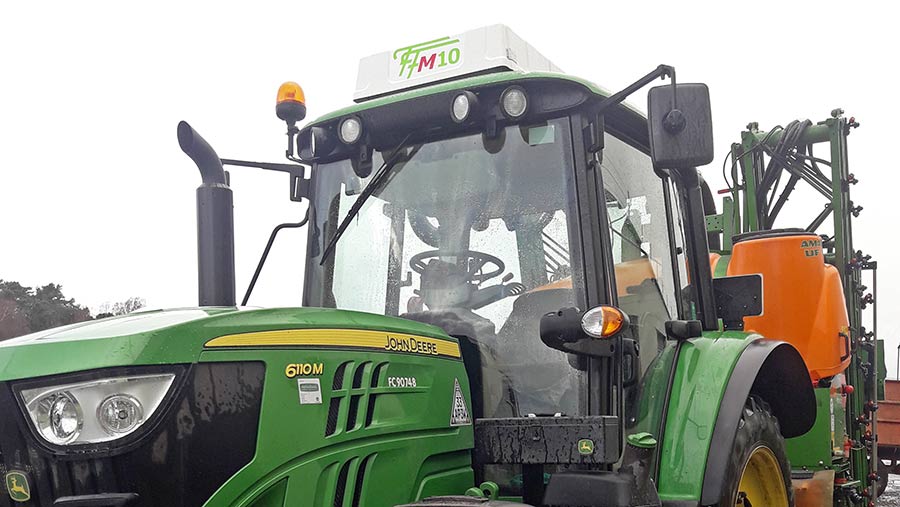
After realising the cabs were only rated to Cat 1, the organisation decided to appoint ODS to improve the level of filtration.
To get the machines up to spec, ODS decided to fit a system designed and built in the Netherlands.
Freshfilter has been making these units for more than 25 years and it promises to get almost any enclosed cabin to surpass the Cat 4 standard.
The process involves sealing up as many of the air gaps in the cab as possible and blocking off the standard air intakes, before fitting a high-spec air purification unit on the cab roof.
Not only does this offer a far higher level of filtration than standard, but it also creates a small pressure difference in the cabin.
This means that if there are any gaps remaining, clean air will be forced out through them, rather than dirty air being able to flow in.
The pressure created by the unit is a minimum of 100 pascals (Pa) (but typically 115Pa) and as soon as the ignition is turned on, this starts working.
If a gap opens up somewhere in the cab, the system will automatically up the blower pressure to compensate, and if the gap gets too large (for example, a window or door is opened), an alarm will sound.
Standards Freshfilter filters meet
- P1 and P2 dust filters – EN779
- P3 dust filter – EN1822 (making it capable of filtering out asbestos dust)
- Activated and impregnated (ABEK) carbon filter – EN1822
According to the firm, if internal cab pressure is less than 100Pa, it’s not sufficient to prevent air coming into the cabin at normal tractor driving speeds.
Interestingly, the current standard for Cat 4 cabins is just 20Pa.
To get the required level of filtration for fine mists created when spraying, the firm uses a large volume activated and impregnated carbon filter.
Apparently, this needs to be at least 10kg to give enough surface area for complete removal of vapours. Standard cab carbon filters are far lower than this.
In an agricultural setting this filter is also protected by an ultra-fine dust filter.
A standard tractor dust filter is rated to about 99% efficiency, which sounds pretty good.
However, Freshfilter’s are 99.9%, and we’re told that last 0.9% makes a lot of difference to the air quality.
A unit mounted in the cab controls the whole system.
This monitors and regulates cabin pressure, shows which filters are installed and records the hours clocked up.
It’s also responsible for sounding the alarm if the cab pressure drops.
Freshfilter has supplied more than 1,000 such units throughout Europe in the past year, and about 10% of these were fitted to tractors.
Most cabs can be fitted with the system, but generally the older they are, the more work is required to seal up the gaps.
Prices to have the system installed on a tractor or self-propelled sprayer range from about £4,000-£5,000.
As for the filters, each set lasts 500 hours and replacements comes in at £550.
The firm also offers an automatic renewal service with email reminders to get the filters replaced on time.
Fitting the system
The tractors being upgraded during our visit included a pair 6110Ms and a 6130M, all of which are fitted with Deere’s M-spec cab rather than the higher-spec R-series. Both are Cat 1 rated though.
The first task was to remove the cab roof and set about sealing all obvious gaps with a combination of foam rubber tapes and plenty of silicon sealant.
![]()
Next, the standard air filters at the rear of the cabin were sealed and a hole was drilled at the top of the B-pillar.
This is where the new filtered air supply from the roof-mounted unit comes in and links up to the tractor’s existing internal airways.
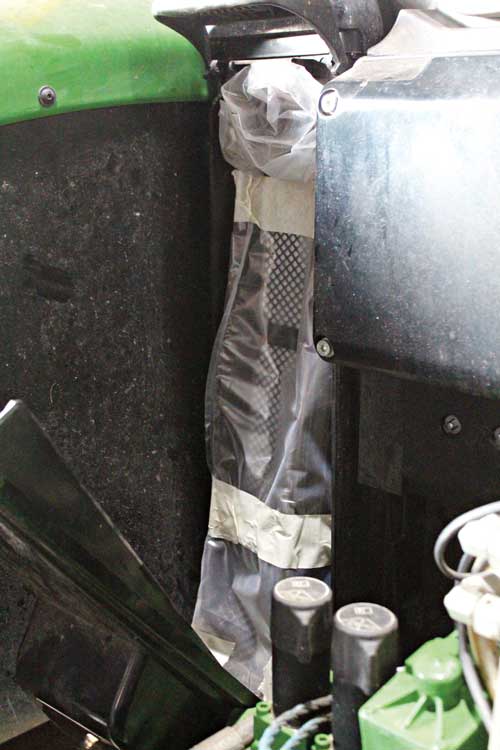
This means the fans, heater and air conditioning unit will work in exactly the same way.
To get power into the unit, the firm tapped into an ignition-switched circuit, meaning the system will run constantly whenever the key is turned.
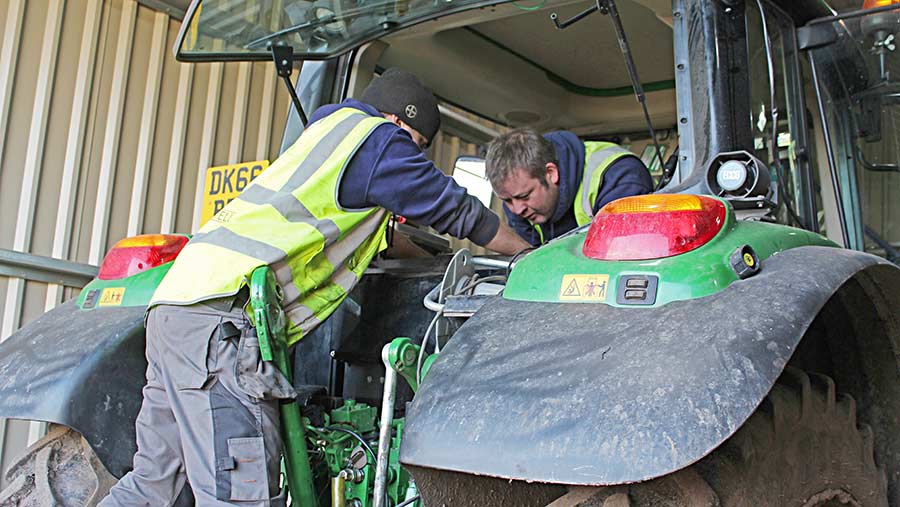
The roof lid was then replaced and sealed before the Freshfilter FFM10 unit was bolted to the roof using a sub-frame.
The air tube was then connected to the inlet pipe on the B-pillar.
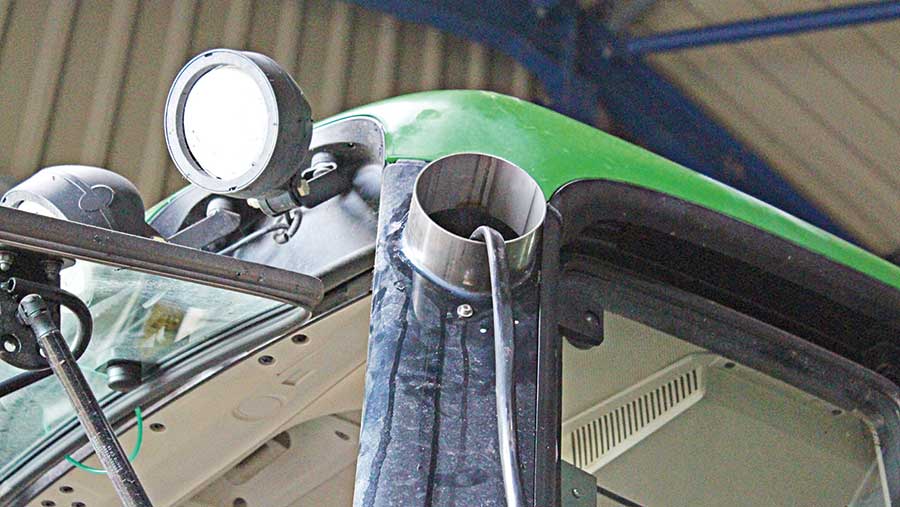
The cable running from the in-cab controller to the unit was also routed through this, preventing the need for additional holes to be drilled.
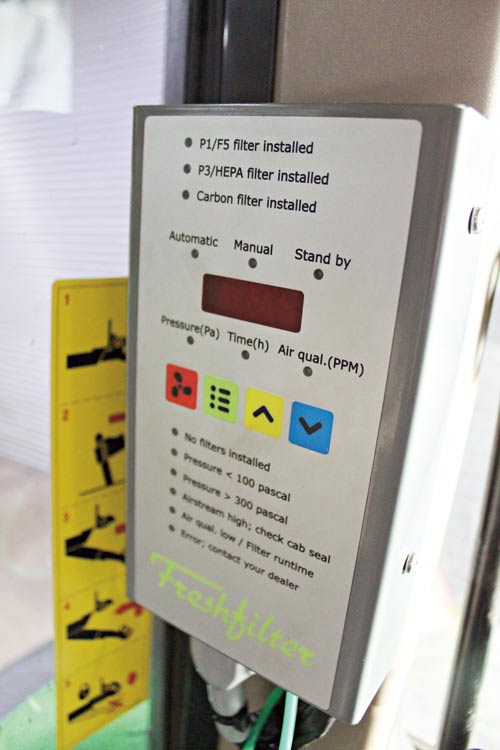
Freshfilter has tried to keep the FFM10 unit as slim as possible to prevent raising the cab roof too high.
However, to give enough space for the large carbon filter, it stands at 205mm tall.

